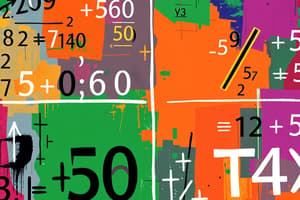Podcast
Questions and Answers
ในคณิตศาสตร์ ความน่าเป็น (mathematical surprises) หมายถึงอะไร?
ในคณิตศาสตร์ ความน่าเป็น (mathematical surprises) หมายถึงอะไร?
- ความแปลกใจของความสัมพันธ์ต่าง ๆ ของตัวเลข (correct)
- ความสวยงามของตัวเลข
- ความปกติของตัวเลข
- ความสมบูรณ์ของตัวเลข
ปัญหาทางคณิตศาสตร์ที่เป็นที่รู้จักอย่างแพร่หลายและยังไม่ได้รับการพิสูจน์ให้ถูกต้องคือ?
ปัญหาทางคณิตศาสตร์ที่เป็นที่รู้จักอย่างแพร่หลายและยังไม่ได้รับการพิสูจน์ให้ถูกต้องคือ?
- ปัญหาสี่สี
- ทฤษฎีบทของโกลดบัช (correct)
- ทฤษฎีบทของพีไทแกรม
- กระบวนการหาร
ปัญหาสี่สีถูกแก้ไขเมื่อใด?
ปัญหาสี่สีถูกแก้ไขเมื่อใด?
- ในศตวรรย์ที่ 20 (correct)
- ในศตวรรย์ที่ 19
- ในศตวรรย์ที่ 17
- ในศตวรรย์ที่ 18
Goldbach Conjecture กล่าวถึงอะไร?
Goldbach Conjecture กล่าวถึงอะไร?
การนับจำนวนสมาชิกของเซ็ตแต่ละชุดเรียกว่าอะไร?
การนับจำนวนสมาชิกของเซ็ตแต่ละชุดเรียกว่าอะไร?
การนับที่ใช้สำหรับการทรวงและนับสิ่งของที่เป็นบริเวณที่แตกต่างกันเรียกว่าอะไร?
การนับที่ใช้สำหรับการทรวงและนับสิ่งของที่เป็นบริเวณที่แตกต่างกันเรียกว่าอะไร?
สูตรที่ใช้สำหรับการหาผลคูณของจำนวนเต็มบวกทุกตัวจนถึงจำนวนที่กำหนดเรียกว่าอะไร?
สูตรที่ใช้สำหรับการหาผลคูณของจำนวนเต็มบวกทุกตัวจนถึงจำนวนที่กำหนดเรียกว่าอะไร?
Permutations ใช้สำหรับการหาอะไร?
Permutations ใช้สำหรับการหาอะไร?
Combinatorics เป็นสาขาของคณิตศาสตร์ที่เกี่ยวข้องกับอะไร?
Combinatorics เป็นสาขาของคณิตศาสตร์ที่เกี่ยวข้องกับอะไร?
Mathematical surprises and counting เสมอคูณกันและดีอย่างไร?
Mathematical surprises and counting เสมอคูณกันและดีอย่างไร?
คำว่า 'ความน่าเป็น' ในภาษาไทย มีความหมายใกล้เคียงกับคำศัพท์ใด?
คำว่า 'ความน่าเป็น' ในภาษาไทย มีความหมายใกล้เคียงกับคำศัพท์ใด?
การวิเคราะห์ความเป็นไปได้ (Predictability Analysis) ใช้สิ่งใดเพื่อประมาณความน่าจะเป็นของเหตุการณ์?
การวิเคราะห์ความเป็นไปได้ (Predictability Analysis) ใช้สิ่งใดเพื่อประมาณความน่าจะเป็นของเหตุการณ์?
สาขาใดใช้การวิเคราะห์ความเป็นไปได้เพื่อทำนายสภาพอากาศ เช่น พยุง การผันแปรของอุณหภูมิ และเหตุการณ์ทางชีวภาพ?
สาขาใดใช้การวิเคราะห์ความเป็นไปได้เพื่อทำนายสภาพอากาศ เช่น พยุง การผันแปรของอุณหภูมิ และเหตุการณ์ทางชีวภาพ?
คำว่า 'ความน่าจะเป็น' เกี่ยวข้องกับการประมาณค่าใด?
คำว่า 'ความน่าจะเป็น' เกี่ยวข้องกับการประมาณค่าใด?
คำว่า 'ความเป็นไปได้' หมายถึงอะไร?
คำว่า 'ความเป็นไปได้' หมายถึงอะไร?
ทำไมความเป็นไปได้สำคัญต่อการเตรียมตัวและการตอบสนองต่อสถานการณ์ที่อาจเกิดขึ้น?
ทำไมความเป็นไปได้สำคัญต่อการเตรียมตัวและการตอบสนองต่อสถานการณ์ที่อาจเกิดขึ้น?
คำว่า 'ความน่าจะเป็น' มีความหมายอย่างไร?
คำว่า 'ความน่าจะเป็น' มีความหมายอย่างไร?
ทำไมคำว่า 'ความน่าจะเป็น' มีความสำคัญ?
ทำไมคำว่า 'ความน่าจะเป็น' มีความสำคัญ?
การจับประมวลความรู้จาก 'ความเป็นไปได้' และ 'ความน่าจะเป็น' ช่วยให้การตัดสินใจที่ดีและโปรแกรมการกระจายทรัพย์ได้อย่างไร?
การจับประมวลความรู้จาก 'ความเป็นไปได้' และ 'ความน่าจะเป็น' ช่วยให้การตัดสินใจที่ดีและโปรแกรมการกระจายทรัพย์ได้อย่างไร?
Flashcards are hidden until you start studying
Study Notes
Title: Exploring the Enigma of Mathematical Surprises: A Journey through Numerical Structure and Counting
Introduction
Mathematics, often considered the language of science, is a fascinating discipline filled with enigmatic wonders. Today, we'll delve into one such facet of mathematics: the concept of "ความน่าเป็น" (mathematical surprises) and "การนับ" (counting), which play a pivotal role in understanding the intricacies of numbers and their properties.
Mathematical Surprises
Mathematical surprises refer to unexpected connections, patterns, and structures that we discover in numbers and mathematical problems. These surprises often leave us amazed and provide new insights into the field.
One of the most famous mathematical surprises is the Goldbach Conjecture, proposed by Christian Goldbach in the 18th century. The conjecture states that every even integer greater than 2 can be expressed as the sum of two prime numbers. This conjecture remains unproved, yet it has sparked curiosity and inspired countless mathematicians to explore the properties of even and prime numbers.
Another celebrated mathematical surprise is the Four Color Problem, which asks whether any map can be colored using no more than four colors in such a way that no two adjacent regions share the same color. This problem also remained unproved for centuries, until it was eventually solved in 1976.
Counting
Counting is a fundamental operation in mathematics, and it forms the basis for many numerical concepts and techniques. Counting has been practiced since ancient times and has played a crucial role in the development of mathematical theory.
The concept of counting can be explored through a variety of subtopics:
Cardinality
Cardinality refers to the number of elements in a set. When we count objects, we assign a cardinal number to the set representing the quantity of its members. For example, the cardinality of a set with 5 red balls is 5.
Discrete and Continuous Counting
Discrete counting involves identifying and counting distinct items, typically by counting the individual elements directly. Continuous counting, on the other hand, involves counting along a continuous path or quantity, such as measuring the distance or volume of an object.
Factorials, Permutations, and Combinations
Factorials, permutations, and combinations are tools used to count the number of distinct arrangements or patterns within a set. Factorials represent the product of all positive integers up to a given number (e.g., 5! = 5 × 4 × 3 × 2 × 1). Permutations count the number of arrangements of elements in a set, considering repetitions, while combinations count the number of arrangements without repetitions.
Combinatorics
Combinatorics is a branch of mathematics that deals with counting and enumerating structures, such as permutations, combinations, and graphs. Some of the most well-known problems in combinatorics include the Traveling Salesman Problem and the Four Color Problem.
The Beauty of Mathematical Surprises and Counting
Mathematical surprises and counting are integral to the field of mathematics, offering us a deeper understanding of numbers and their properties. The beauty of these concepts lies in their simplicity and universality. Mathematical surprises help us to discover connections and patterns that may have previously eluded our attention, while counting provides a foundational framework for understanding numerical quantities.
Moreover, the exploration of mathematical surprises and counting plays a crucial role in fostering creativity and problem-solving skills. Through the study of these concepts, mathematicians can develop a heightened sense of logic, pattern recognition, and critical thinking.
Conclusion
Mathematical surprises and counting are two captivating subtopics within the field of mathematics, offering profound insight into the world of numbers and their properties. The study of these concepts not only deepens our understanding of the subject but also nurtures our curiosity, creativity, and problem-solving skills. As we continue to explore these topics, we discover new mathematical puzzles and challenges, pushing the boundaries of human knowledge and fostering our collective pursuit of truth and understanding.
Studying That Suits You
Use AI to generate personalized quizzes and flashcards to suit your learning preferences.





